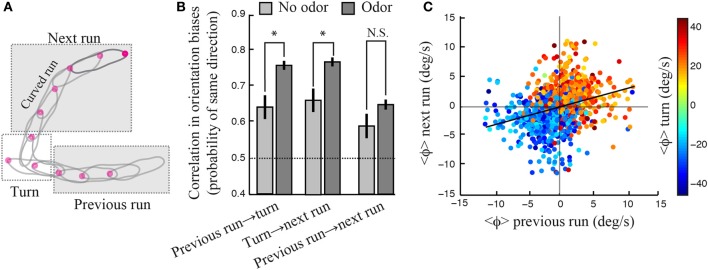Figure 4.

Contribution of motor memory to reorientation maneuvers. (A) Schematic drawing illustrating a run leading to a turn followed by a run. (B) Conditional probability that the directional bias between two consecutive events—run or turn—be the same. In the absence of odor (light gray bar), wild type larvae show a significant correlation between the direction of consecutive runs and turns, which demonstrates the existence of a purely motor memory. This directional bias is stronger upon odor stimulation, suggesting that sensory stimulation results in a behavioral enhancement. There is a small, yet significant, correlation between the directions of consecutive runs considered irrespectively to the turn in-between. However, this correlation is not strengthened in the presence of odor (two-sample t-test, p > 0.09). Standard t-tests were used to compare the means observed in the absence and the presence of odor (*p < 0.001). The difference of the mean probability with chance (0.5) is highly significant for every group (one-sample t-test, p < 0.001), except for the no-odor previous-run-to-next-turn condition (p = 0.009). Error bars denote s.e.m. (C) Mean reorientation rate of a given run and the subsequent run (N = 1236). The color code indicates the mean reorientation rate during the turns linking two runs. Although the linear correlation is weak (slope = 0.31, R2 = 0.0969), the grouping of points by color indicates that weathervaning is contingent on the directionality of past runs and turns. In (B,C), the reorientation bias associated with a given run is computed as the average of the instantaneous reorientation rates occurring during this run.
